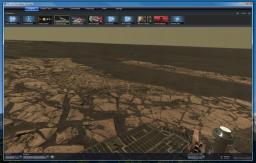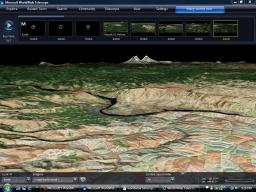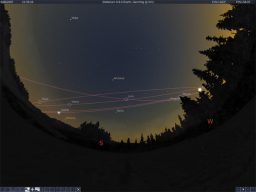 Joining Google Sky and Stellarium is Microsoft’s entrant to the stars, Worldwide Telescope. I’ve been playing around with it for about an hour and it’s pretty cool. It effectively turns every computer that downloads it into a mini-planetarium capable of displaying high resolution images of millions of stars, planets and other celestial.
Joining Google Sky and Stellarium is Microsoft’s entrant to the stars, Worldwide Telescope. I’ve been playing around with it for about an hour and it’s pretty cool. It effectively turns every computer that downloads it into a mini-planetarium capable of displaying high resolution images of millions of stars, planets and other celestial.Any Star Wars , Star Trek fan (like me) knows that space travel is not always easy, but Microsoft wants to make traveling the ‘final frontier’ as simple as turning on your computer.
First of all I was happy to see that Microsoft has came out of “ ~ ta’s “ naming ( e.g. Vista, Lista, Volta … that “ta” was getting on my nerves ), “Worldwide Telescope” is a bit old skool name, inspired from you know what … I can live with this one.
OK, now Check it out if you’re an outer space dork — it includes a bunch of guided tours from astronomers. I liked the “many worlds” tour, which started with Mount St. Helen’s ranges and then flew off to the rest of the planets in our solar system for some hot world-on-world action. A tour called “Dust and Us” walks through the dark regions in galaxies where stars and planets form.
 The software allows users to develop their own guided tours of the universe to share with others or take part a guided tour created by astronomy experts.
The software allows users to develop their own guided tours of the universe to share with others or take part a guided tour created by astronomy experts.The WorldWide Telescope stitches together 12 terabytes – the data of pictures from sources including the Hubble Space Telescope, the Chandra X-Ray Observatory Center and the Spitzer Space Telescope.
The experience is similar to playing a video game, allowing users to pan, zoom in and out of galaxies that are thousands of light years away. It allows seamless viewing of far, far away star systems and rarely-seen space dust in breathtaking clarity.
I can use WorldWide Telescope for 4 different “looks” – Panorama, Sky, Earth, or Planets. Users can see the X-ray view of the sky, zoom into bright radiation clouds, and then cross-fade into the visible light view and discover the cloud remnants of a supernova explosion from a thousand years ago.
Other data sets include the ongoing Sloan Digital Sky Survey, also known as the Cosmic Genome Project, which aims to capture detailed optical images of more than a quarter of the night sky.
By default, WorldWide Telescope is configured to view the night sky as if you were standing at Microsoft Building 99 in Redmond. But you can change your Observing Location very easily via View options.
Experience WWT:
To use the new system, users need to download WorldWide Telescope from the web ( it’s free ). It only runs on Windows operating systems ( M$ strikes back ! … as usual )
The System Requirements does include 2GB of RAM , 3D accelerated card with 128 megabytes (MB) RAM; discrete graphics card with dedicated 256-MB VRAM, but i’m using it on my PC : Windows Vista, intel CTD 2.2 G Hz, 1 GB RAM, no graphics card, and it just works fine.
A test version is available for download at: http://www.worldwidetelescope.org
P.S. - it’s interesting how the site is made using Adobe Flash and not Silverlight. … yehh !!
Other options :
Google Sky, an add-on to Google Earth has been there for some time, but I found WorldWide Telescope’s GUI, and overall experience better than Google sky.
 Stellarium is a free open source tool that gives people a chance to access more than 210 million stars, in addition to planets and moons. The project was launched in 2001 and is used in many planetariums.
Stellarium is a free open source tool that gives people a chance to access more than 210 million stars, in addition to planets and moons. The project was launched in 2001 and is used in many planetariums.Like WorldWide Telescope the software allows users to record and play their own tours of the Universe. Stellarium is really good, and Microsoft must continue taking WorldWide Telescope to next levels to stay ahead.
Stellarium is just wonderful. Best of all is that it is not quite the memory and system resource hog that Starry Night Basic and Pro is ( it is one more option ). In fact, I have found that the latest versions of Starry Night often will not run on computers that are a few years old. It gives good view of what the sky would look like from pretty much anywhere on Earth at any time over a wide range of dates. If you want to know what stars and constellations are which, if you are an amateur planning an observing session, or you have any other need for a basic planetarium software, then this seems good.
Future From My View:
- WorldWide Telescope is not bad, but it’s not great either. It would be better as an online app where people can share access to their telescopes. People with better telescopes with the servo system and the drivers and the right CCD. They could sell time on their equipment via the Internet or at least share it with some new Microsoft or Google services.. A virtual space marketplace. I would pay for something like that and so would a lot of people.
- I see social network interaction potential in developing our own guided tours and sharing them. We can have forums facility bundled where people interested in common space topics can interact and share information through custom tours and traditional chat.
- This software will be like having an important educational mission.
- Microsoft will never learn it…
Under download for Mac: ‘Minimum Windows XP SP2 , Vista recommended …with BootCamp”
Guys a Mac running Windows IS NOT A MAC, it’s like a beautiful woman wearing a sack and led boots….
Anyhow, they don’t seem to get it that clinging to their old lady OS doesn’t fly anymore.
- In the hollywood hills we only use telescopes to see into our neighbors houses. let me know when someone comes out with that one...!!!
No comments:
Post a Comment